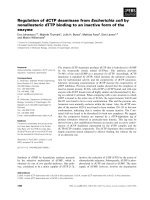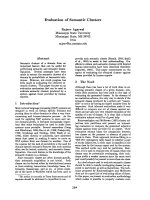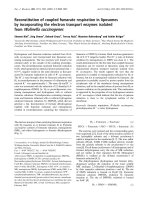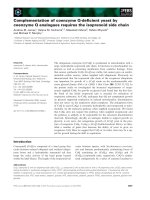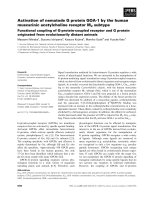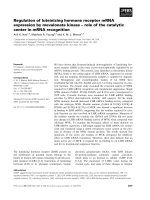Báo cáo khoa học: " Evaluation of the effects of climatic and nonclimatic factors on the radial growth of Yezo spruce (Picea jezoensis Carr) by dendrochronological methods" pps
Bạn đang xem bản rút gọn của tài liệu. Xem và tải ngay bản đầy đủ của tài liệu tại đây (549.88 KB, 10 trang )
Original
article
Evaluation
of
the
effects
of
climatic
and
nonclimatic
factors
on
the
radial
growth
of Yezo
spruce
(Picea jezoensis
Carr)
by
dendrochronological
methods
Osamu
Kobayashi
a
Ryo
Funada
b
Koh
Yasue
b
Jun
Ohtani
b
a
Komeno-no
Forest
Research
Center,
Experiment
Forest
of
Ehime
University,
Ohino-machi
145-2,
Matsuyama,
Ehime
791-01,
Japan
b
Laboratory
of
Wood
Biology,
Department
of
Forest
Science,
Faculty
of
Agriculture,
Hokkaido
University,
Sapporo
060,
Japan
(Received
23
May
1997;
accepted
5
November
1997)
Abstract -
The
responses
to
climatic
and
nonclimatic
factors
of
Yezo
spruce
(Picea jezoensis
Carr)
trees
growing
in
a
natural
forest
in
Tomakomai,
Hokkaido
were
analyzed
by
dendrochronolog-
ical
methods.
The
effects
of climatic
factors
were
examined
by
response
function
analysis.
More
than
70 %
of
the
variance
of
ring-width
and
maximum-density
indices
was
explained
by
cli-
matic
data
from
1924
to
1965.
The
effect
of
nonclimatic
factors
on
radial
growth
from 1966
to
1990
was
analyzed
by
comparing
actual
indices
with
the
estimated
indices
of
ring
width
and
maximum
density
calculated
from
the
climatic
data.
Actual
ring-width
indices
were
lower
than
the
esti-
mated
indices
every
year
from
1969
to
1977.
Actual
maximum-density
indices
were
lower
than
the
estimated
indices
every
year
from
1971
to
1974.
These
results
indicate
that
some
noncli-
matic
factors
might
have
affected
both
ring
width
and
maximum
density
in
the
1970s.
(©
Inra/Elsevier,
Paris.)
Picea jezoensis
Carr
/
ring
width
/
maximum
density
/
X-ray
densitometry
/
response
function
analysis
Résumé -
Évaluation
des
effets
des
facteurs
climatiques
et
non
climatiques
sur
la
crois-
sance
radiale
de
l’épinettes
de
yezo
(Picea jezoensis
Carr)
par
les
méthodes
dendrochro-
nologiques.
Les
réponses
aux
facteurs
climatiques
et
non
climatiques
de
l’épinette
de
yezo
(Picea jezoensis
Carr)
ont
été
étudiées
dans
des
forêts
naturelles
du
Tomakomai,
dans
l’île
d’Hokkaido,
par
les
méthodes
dendrochronologiques.
Les
effets
des
facteurs
climatiques
ont
été
examinés
par l’analyse
de
fonctions
de
réponse.
Plus
de
70 %
de
la
variance
des
indices
de
lar-
*
Correspondence
and
reprints
E-mail:
geur
des
cernes
annuels
et
de
densité
maximale
ont
été
expliqués
par
les
données
climatiques
de
1924
à
1965.
L’effet
des
facteurs
non
climatiques
sur
la
croissance
radiale
de
1966
à
1990
a
été
étudié
par
la
comparaison
des
indices
actuels
et
des
indices
estimés
de
largeur
des
cernes
annuels
et
de
densité
maximale,
calculés
d’après
les
données
climatiques.
Les
indices
actuels
de
largeur
des
cernes
annuels
pour
les
années
1969
à
1977
sont inférieurs
aux
indices
estimés.
Les
indices
actuels
de
densité
maximale
pour
les
annés
1971
à
1974
sont inférieurs
aux
indices
estimés.
Les
résultats
indiquent
que
des
facteurs
non
climatiques
affectent
probablement les
largeurs
de
cernes
annuelles
et
la
densité
maximale
au
cours
des
années
1970.
(©
Inra/Elsevier,
Paris.)
Picea jezoensis
Carr
/
largeur
de
cerne
annuel / densité
maximale
/
densitométrie
au
rayon-X
/
fonctions
de
réponse
1.
INTRODUCTION
Climate
is
one
of
the
most
important
factors
that
influences
the
variance
of
ring
widths
and
wood
densities
[14].
Statistical
methods
have
been
widely
used
to
assess
relationships
between
climatic
data
and
ring
widths
or
wood
densities
[3-5,
10,
14, 28].
However,
nonclimatic
factors,
such
as
air
pollution,
also
affect
the
vari-
ance
of
ring
widths
and
wood
densities
[12,
13, 19,
24,
26,
32].
Thus,
ring
widths
and
wood
densities
provide
records
of
the
effects
of
both
climatic
and
nonclimatic
factors
on
the
radial
growth
of
trees.
It
is
possible
to
evaluate
the
effects
of
noncli-
matic
factors
on
the
radial
growth
of
trees
in
the
past
by
comparing
actual
ring-width
or
wood-density
indices
with
estimated
indices
calculated
from
the
climatic
data
[6, 9].
Previous
studies
have
shown
that
vari-
ations
in
ring
widths,
ring
densities
or
maximum
densities
of
Sakhalin
spruce
(Picea
glehnii
Mast)
[23,
31],
Japanese
ash
(Fraxinus
mandshurica
Rupr
var
japonica
Maxim)
[30]
and
Norway
spruce
(Picea
abies
Karst)
[20]
trees,
which
are
growing
in
Hokkaido,
are
correlated
with
monthly
temperature
or
precipitation.
Yezo
spruce
(Picea jezoensis
Carr)
is
one
of
the
species
that
provides
the
longest
tree-ring
chronologies
in
Hokkaido,
Japan.
However,
no
dendrochronological
approach
to
an
understanding
of
the
effects
of
climatic
and
nonclimatic
factors
on
Yezo
spruce
has
been
reported.
Our
pre-
vious
study
[21,
22]
revealed
an
abrupt
decrease
in
ring
width
of
Yezo
spruce
and
Norway
spruce
trees
in
the
Tomakomai
forest,
which
is
located
near
an
industrial
district,
from
the
late
1960s
to
the
mid
1970s.
This decrease
might
have been
due
to
nonclimatic
factors,
such
as
air
pollu-
tion.
However,
the
variance
in
ring
widths
due
to
nonclimatic
factors
has
not
been
evaluated
by
statistical
analysis.
Thus,
it
is
necessary
to
characterize
the
effects
of
nonclimatic
factors
on
radial
growth
by
a
statistical
elimination
of
the
variance
in
ring
widths
or
maximum
densities
that
is
due
to
climate.
In
this
study,
the
statistical
relation-
ships
between
climatic
data
and
ring-width
or
maximum-density
indices
were
inves-
tigated
by
response
function
analysis
[14],
which
has
been
widely
used
to
assess
rela-
tionships
between
climatic
data
and
ring
widths
or
wood
densities.
We
investigated
the
influence
of
nonclimatic
stress
factors
by
comparing
actual
ring-width
or
maxi-
mum-density
indices
with
estimated
indices
calculated
from
the
response
func-
tions
that
corresponded
to
the
period
prior
to
the
onset
of
exposure
to
putative,
non-
climatic
stress
factors.
2.
MATERIALS
AND
METHODS
2.1.
Study
sites
We
examined
Yezo
spruce
trees
at
five
sites
in
the
natural
forest
at
the
National
Forest
of
the
Japan
Forestry
Agency
(Tomakomai
District
Office,
Tomakomai
City,
Hokkaido,
Japan;
figure
1).
The
cores
used
in
this
study
were
sampled
from
naturally
growing
Yezo
spruce
trees
with
little
human
treatment
such
as
thin-
ning
and
cutting.
The
topography
and
geology
of
the
five
sites
are
quite
similar.
Soils
are
com-
posed
of
shallow
A
horizons,
with
infertile
vol-
canogenous
regosols.
The
Tomakomai
Indus-
trial
District,
where
factories
began
operation
in
1968,
is
located
on
the
coast
in
Tomakomai
city.
The
distance
from
the
industrial
district
to
the
nearest
site
was
approximately
10
km,
and
that
to
the
most
remote
site
was
approxi-
mately
20
km.
All
sites
were
frequently
exposed
to
winds
from
the
industrial
district
from
April
to
September.
2.2.
Collection
and
treatment
of
samples
Fifteen
Yezo
spruce
trees
were
selected
from
the
five
natural
sites
(table
I).
The
trees
were
selected
to
represent
similar
site
condi-
tions
throughout
all
sites
to
minimize
any
vari-
ability
due
to
extraneous
factors.
Thirty
cores
in
all
were
collected,
with
two
cores
taken
from
different
directions
in
each
tree
at
breast
height.
The
cores
were
cut
into
2-mm-thick
strips,
and
then
they
were
dried
and
irradiated
with
soft
X-rays
at
15
kV
and
5
mA
for
240
s from
a
distance
of
1.5
m.
The
X-ray
films
were
scanned
with
a
microdensitometer
(PDS-15;
Konica,
Japan).
Ring-width
and
maximum-
density
series
were
obtained
by
application
of
the
Tree-Ring
Analysis
Program
(Y.
Nobori,
Faculty
of
Agriculture,
Yamagata
University,
1989).
2.3.
Crossdating
and
standardization
All
cores
were
crossdated
visually
by
skele-
ton
plot
procedures
[11,
29]
and
crossdating
was
later
verified
by
a
statistical
method
using
the
COFECHA
program
[18].
The
COFECHA
program
tests
each
individual
ring-width
and
maximum-density
series
against
a
master
dat-
ing
series
(mean
of
all
series)
on
the
basis
of
correlation
coefficients.
Careful
crossdating
eliminates
absent
and
false
rings,
as
well
as
measurement
errors,
which
reduce
the
statisti-
cal
accuracy
of
site
chronologies
of
ring
width
and
maximum
density.
Twenty-four
cores
from
13
trees
were
successfully
crossdated
(table
I).
All
24
series
are
plotted
in figure
2.
Crossdated
ring-width
and
maximum-den-
sity
series
were
standardized
to
eliminate
indi-
vidual
growth
trends,
such
as
age-related
declines
and
low-frequency
variance
due
to
natural
disturbance.
The
ring-width
and
max-
imum-density
series
were
standardized
by
first
fitting
a
trend
line
and
then
dividing
the
mea-
sured
data
by
the
corresponding
fitted
data
for
the
given
year.
A
stiff
spline-function
[8],
pass-
ing
50 %
of
the
variance
of
the
measured
series
at
frequencies
greater
than
70
years,
was
adapted
to
the
ring-width
series.
A
horizontal
line
that
crossed
the
mean
maximum-density
values
of
each
series
was
adapted
to
the
max-
imum-density
series.
Remaining
autocorrela-
tions
in
the
ring-width
and
maximum-density
series
that
might
adversely
affect
significance
tests
in
the
response
function
analysis
were
removed
by
pooled
autoregressive
modeling
[7].
Thus,
the
common
variance
in
ring-width
and
maximum-density
series
of
all
cores
that
was
due
to
climatic
and
regional
nonclimatic
factors
was
extracted
by
this
standardization
procedure.
Standardization
of
the
ring-width
and
maximum-density
series
was
performed
using
the
ARSTAN
program
(R.L.
Holmes,
Laboratory
of
Tree-Ring
Research,
University
of
Arizona,
1996).
Standardized
individual
ring-width
and
maximum-density
indices
were
averaged
using
the
arithmetic
mean
to
establish
the
master
chronologies
of
Yezo
spruce
at
Tomakomai
from
1828
to
1993
(figure
3).
Statistics
for
the
master
chronologies
of
ring-
width
and
maximum-density
indices
are
pre-
sented
in
table
I.
2.4.
Response
function
analysis
The
growth-climate
relationship
for
the
period
from
1924
to
1965
(n
=
42
years)
was
calculated
by
response
function
analysis
[2,
14,
17].
Response
function
analysis
is
a
multi-
ple-regression
technique
that
uses
principal
components
of
monthly
climatic
data
as
pre-
dictors
of
ring-width
and
maximum-density
indices
(the
predictands).
The
principal
com-
ponents
of
monthly
climatic
data
were
origi-
nally
used
to
eliminate
the
intercorrelations
between
the
predictor
variables
[14].
The
cal-
culation
of
response
functions
was
performed
with
the
PRECON
program
(H.C.
Fritts,
Den-
dro-Power,
Tucson,
Arizona,
1996)
[15].
Sim-
ple
correlation
was
also
calculated
to
confirm
the
results
of
response
functions
since
response
functions
are
sensitive
to
various
parameters,
such
as
the
confidence
level,
number
of
eigen-
vectors
and
climatic
variables
[1].
Monthly
mean
temperatures
and
monthly
total
precipitation
at
the
Muroran
Meteoro-
logical
Observatory
of
the
Japan
Meteorolog-
ical
Agency
(Sapporo
District
Meteorological
Observatory,
1991),
located
approximately
60
km
southwest
of
Tomakomai
city,
were
used
for
response
function
analysis.
We
used
the
data
from
Muroran
because
of
the
longer
weather
records
at
Muroran
(1924 -
1990)
as
compared
to
those
at
the
Tomakomai
Weather
Station
(located
approximately
10
km
south
of
the
study
sites).
Monthly
climatic
data
at
Muro-
ran
were
strongly
correlated
(R
≥ 0.6,
P
< 0.0001)
with
those
at
Tomakomai.
Estimated
ring-width
and
maximum-den-
sity
indices
were
calculated
by
substituting
cli-
matic
data
into
the
regression
equations
of
the
response
functions.
The
response
functions
used
for
the
calibration
of
estimated
indices
were
calculated
for
the
period
from
1924
to
1965
(calibration
period),
namely
for the
period
before
the
factories
at
the
industrial
district
became
operational.
Estimated
ring-width
and
maximum-density
indices
were
compared
with
the
actual
ring-width
and
maximum-density
indices
for
the
period
from
1966
to
1990
(ver-
ification
period).
Nonclimatic
variations
in
ring-width
and
maximum-density
indices
were
investigated
by
comparing
the
actual
and
esti-
mated
indices.
3.
RESULTS
AND
DISCUSSION
3.1.
Response
function
analysis
The
results
of
response
function
anal-
ysis
showed
that
78
%
of
the
variance
in
ring-width
indices
could
be
explained
by
climate
(figure
4).
Ring
width
exhibited
a
negative
response
to
temperature
in
the
previous
September,
which
was
signifi-
cant
with
respect
to
both
the
response
function
and
simple
correlation.
Ring
width
also
exhibited
a
significant
positive
response
to
temperature
in
the
current
April
and
a
negative
response
to
temper-
ature
in
the
current
June.
Seventy-four
percent
of
the
variance
in
maximum-density
indices
could
be
explained
by
climate
(figure
4).
Maximum
density
exhibited
a
significant
positive
response
to
temperature
in
the
previous
July.
In
addition,
the
maximum
density
exhibited
a
significant
positive
response
to
precipitation
in
the
previous
October.
Our
results
show
the
influences
of tem-
perature
in
the
previous
autumn
and
cur-
rent
spring
on
ring
width
of
Yezo
spruce
growing
at
Tomakomai.
Ring
width
of
Sakhalin
spruce
growing
close
to
our
experiment
site
shows
a
similar
positive
response
to
temperature
in
the
current
April
[23].
However,
the
response
of
ring
width
to
other
climatic
data
differed
between
Yezo
spruce
and
Sakhalin
spruce.
On
the
other
hand,
both
maximum
den-
sity
of
Sakhalin
spruce
growing
in
north-
em
Hokkaido
[31]
and
latewood
density
of
Sakhalin
spruce
growing
at
Tomakomai
[23]
show
a
similar
positive
response
to
temperature
from
the
current
August
to
September.
However, this
response
to
tem-
perature
in
the
current
summer
was
not
evident
in
the
maximum
density
of
Yezo
spruce
growing
at
Tomakomai.
Therefore,
the
radial
growth
of
Yezo
spruce
and
Sakhalin
spruce,
which
are
growing
at
Tomakomai,
may
respond
differently
to
seasonal
climate.
Previous
studies
have
also
indicated
that
dissimilarities
in
growth
responses
to
climate
are
related
to
species
differences
rather
than
to
site
differences
[16, 25].
3.2.
Comparison
between
actual
and
estimated
indices
The
influence
of
nonclimatic
factors
from
1966
to
1990
was
investigated
by
comparing
the
actual indices
and
the
esti-
mated
indices
for
both
ring
width
and
maximum
density.
Figure
5 shows
the
actual
indices
and
estimated
indices
for
ring
width
and
maximum
density.
Shaded
areas
indicate
actual
indices
that
were
lower
than
estimated
indices.
During
the
verification
period,
both
actual
ring-width
indices
and
maximum-density
indices
were
very
low
as
compared
to
estimated
indices.
Actual
ring-width
indices
were
lower
than
estimated
indices
from
1966
to
1967,
from
1969
to
1977,
from
1981
to
1984
and
from
1988
to
1989.
Actual
max-
imum-density
indices
were
lower
than
the
estimated
indices
in
1966,
in
1969,
from
1971
to
1974,
from
1978
to
1979,
from
1981
to
1982,
in
1987
and
in
1989.
In
par-
ticular,
actual
ring-width
indices
were
lower
than
estimated
every
year
from
1969
to
1977
and
actual
maximum-density
indices
were
lower
than
estimated
every
year
from
1971
to
1974.
The
climatic
data
show
that
the
August
precipitation
in
1981
was
extremely
high.
This
climatic
event
might
have
caused
the
overestimation
of
ring-width
and
maximum-density
indices
from
1981
to
1982.
However,
climatic
events
that
might
reduce
the
radial
growth
of
Yezo
spruce
trees
in
the
1970s
are
not
shown
in
the
climatic
data.
These
results
indicate
that
nonclimatic
stress
factors
reduced
the
radial
growth
of
Yezo
spruce
trees
in
the
1970s.
Our
previous
study
[22]
revealed
an
abrupt
reduction
in
ring
width
of
Yezo
spruce
from
1969
to
1979,
with
an
increas-
ing
extent
of reduction
from
1972
onwards.
Norway
spruce
trees
growing
in
the
same
region
also
showed
an
extreme
reduction
in
ring
width
around
1970.
The
extent
of
this
growth
reduction
was
related
to
the
distance
from
the
industrial
district
[21, 22].
These
reductions
in
ring
width
in
Yezo
spruce
and
Norway
spruce
in
the
1970s
reflect
the
records
of
industrial
activity
near
the
forest.
During
this
period,
neither
the
meteorological
data
nor
the
forest
management
record
shows
the
evi-
dence
of
typhoon
effects,
insect
pests
or
tree
disease
that
might
reduce
the
radial
growth
of
the
trees.
Therefore,
we
postu-
lated
that
air
pollution
from
the
industrial
district
might
have
caused
the
reductions
in
ring
width
of Yezo
spruce
and
Norway
spruce
since
1969
[22].
The
present
results
of
our
statistical
analysis
support
the
hypothesis
that
nonclimatic
stress
factors,
such
as
air
pollution,
became
important
in
the
1970s.
Response
function
analysis
revealed
that
ring-width
and
maximum-density
indices
of
Yezo
spruce
exhibited
signifi-
cant
responses
to
climatic
data.
We
were
also
able
to
estimate
the
effects
of
noncli-
matic
stress
factors,
such
as
air
pollution,
by
comparing
actual
and
estimated
indices
of
ring
width
or
maximum
density.
Thus,
it
is
apparently
possible
to
estimate
the
effects
of
nonclimatic
stress
factors
on
the
radial
growth
by
applying
the
statistical
techniques
that
are
used
in
den-
drochronology.
This
method
might
be
use-
ful
to
assess
the
effects
of
nonclimatic
stress
factors
on
tree
growth
in
the
past
when
historical
evidence
of
a
reduction
in
tree
growth
is
not
available.
ACKNOWLEDGMENTS
The
authors
thank
Drs
K.
Ishigaki
and
Y.
Tanaka
at
the
Experimental
Forest
of
Hokkaido
University
for
technical
assistance.
The
authors
also
thank
the
staff
of
the
National
Forest
of
the
Japan
Forestry
Agency
(Tomakomai
Dis-
trict
Office,
Tomakomai
City,
Hokkaido,
Japan)
for
providing
assess
to
the
experimen-
tal
trees.
Part
of
this
work
was
supported
by
the
Showa
Shell
Sekiyu
Foundation
for
the
Promotion
of
Environmental
Research.
REFERENCES
[1]
Blasing
T.J.,
Solomon
A.M.,
Duvick
D.N.,
Response
functions
revisited,
Tree-Ring
Bull.
44 (1984) 1-15.
[2]
Briffa
K.,
Cook
E.R.
Methods
of
response
function
analysis,
in:
Cook
E.R.,
Kairiukstis
L.A.
(Eds.),
Methods
of
Dendrochronology:
Applications
in
the
Environmental
Sciences,
Kluwer
Academic
Publishers,
Dordrecht,
Netherlands,
1990,
pp.
240-247.
[3]
Briffa
K.R.,
Jones
P.D.,
Pilcher
J.R.,
Hughes
M.K.,
Reconstructing
summer
temperatures
in
northern
Fennoscandinavia
back
to
AD
1700
using
tree-ring
data
from
Scots
pine,
Arct.
Alp.
Res.
20
(1988)
385-394.
[4]
Cleaveland
M.K.,
Climatic
response
of
den-
sitometric
properties
in
semiarid
site
tree
rings,
Tree-Ring
Bull.
46
(1986)
13-29.
[5]
Conkey
L.E.,
Response
of
tree-ring
density
to
climate
in
Maine,
USA,
Tree-Ring
Bull.
39
(1979) 29-38.
[6]
Conkey
L.E.,
Decline
in
old-growth
red
spruce
in
western
Maine:
an
analysis
of
wood
density
and
climate,
Can.
J.
For.
Res.
18
(1988) 1063-1068.
[7]
Cook
E.R.,
A
time
series
analysis
approach
to
tree-ring
standardization,
Ph.D.
thesis,
Uni-
versity
of
Arizona,
Tucson,
AZ,
USA,
1985.
[8]
Cook
E.R.,
Peters
K.,
The
smoothing
spline:
a
new
approach
to
standardizing
forest
inte-
rior
tree-ring
width
series
for
dendroclimatic
studies,
Tree-Ring
Bull.
41
(1981)
45-53.
[9]
Cook
E.R.,
Johnson
A.H.,
Blasing
T.J.,
For-
est
decline:
modeling
the
effect
of
climate
in
tree
rings,
Tree
Physiol.
3
(1987)
27-40.
[ 10]
D’Arrigo
R.D.,
Jacoby
G.C.,
Free
R.M.,
Tree-
ring
width
and
maximum
latewood
density
at
the
North
American
tree
line:
parameters
of
climate
change,
Can.
J.
For.
Res.
22
(1992)
1290-1296.
[11]
Douglass
A.E.,
Crossdating
in
den-
drochronology.,
J.
For.
39
(1941)
825-831.
[12]
Eckstein
D.,
Krause
C.,
Dendroecological
studies
on
spruce
trees
to
monitor
environ-
mental
changes
around
Hamburg,
IAWA
Bull.
10 (1989)
175-182.
[13]
Eckstein
D.,
Krause
C.,
Bauch
J.
Dendroe-
cological
investigation
of
spruce
trees
(Picea
abies
(L)
Karst)
of
different
damage
and
canopy
classes,
Holzforschung
43
(1989)
411-417.
[14]
Fritts
H.C.,
Tree
Rings
and
Climate,
Aca-
demic
Press,
New
York,
1976.
[15]
Fritts
H.C.,
Vaganov
E.A.,
Sviderskaya
I.V.,
Shashkin
A.V.,
Climatic
variation
and
tree-
ring
structure
in
conifers:
empirical
and
mech-
anistic
models
of
tree-ring
width,
number
of
cells,
cell
size,
cell-wall
thickness
and
wood
density,
Clim.
Res.
1 (1991)
97-116.
[16]
Graumlich
L.J.,
Response
of
tree
growth
to
climatic
variation
in
the
mixed
conifer
and
deciduous
forest
of
the
upper
Great
Lakes
region,
Can.
J.
For.
Res.
23
(1993)
133-143.
[17]
Guiot
J.,
The
bootstrapped
response
function,
Tree-Ring
Bull.
51
(1991) 39-41.
[18]
Holmes
R.L.,
Computer-assisted
quality
con-
trol
in
tree-ring
dating
and
measurement,
Tree-Ring
Bull.
43
(1983)
69-78.
[19]
Innes
J.L.,
Cook
E.R.,
Tree-ring
analysis
as
an
aid
to
evaluating
the
effects
of
pollution
on
tree
growth,
Can.
J.
For.
Res.
19
(1989)
1174-1189.
[20]
Kobayashi
O.,
Fukazawa
K.,
Ohtani
J.,
Den-
sitometric
analysis
on
tree
rings
of
non-vital
conifers
growing
in
Hokkaido,
Japan,
in:
Ohta
S.,
Fujii
T.,
Okada
N.,
Hughes
M.K.,
Eck-
stein
D.
(Eds.),
Tree
Rings:
from
the
Past
to
the
Future,
Proc.
of
the
International
Work-
shop
on
Asian
and
Pacific
Dendrochronol-
ogy Tsukuba,
Japan,
1995,
pp.
146-150.
[21]
Kobayashi
O.,
Funada
R.,
Fukazawa
K.,
Ohtani
J.,
Abrupt
growth
changes
in
Norway
spruce
and
Yezo
spruce
near
an
industrial
district
in
Hokkaido,
Japan,
Trees
11
(1997)
183-189.
[22]
Kobayashi
O.,
Funada
R.,
Fukazawa
K.,
Ohtani
J.,
A
dendrochronological
evaluation
of
the
effects
of
air
pollution
on
the
radial
growth
of
Norway
spruce,
Mokuzai
Gakkaishi,
43
(1997)
824-831.
[23]
Nobori
Y.,
An
analysis
of
the
relationships
between
weather
information
and
tree
ring
information
of
194
samples
from
a
Picea
glehnii
Mast
plantation
in
the
Tomakomai
district
by
X-ray
densitometry,
J.
Jpn.
For.
Soc.
76
(1994) 89-94.
[24]
Ohta
S.
The
observation
of
tree
ring
struc-
ture
by
soft
X-ray
densitometry
(I):
the
effects
of
air-pollution
on
annual
ring
structure,
Mokuzai
Gakkaishi
24
(1978)
429-434.
[25]
Peterson
D.W.,
Peterson
D.L.,
Effects
of
cli-
mate
on
radial
growth
of
subalpine
conifers
in
the
North
Cascade
Mountains,
Can.
J.
For.
Res. 24 (1994)
1921-1932.
[26]
Sander
C.,
Eckstein
D.,
Kyncl
J.,
Dobry
J.,
The
growth
of
spruce
(Picea
abies
(L)
Karst) in
the
Krkonose-(Giant)
Mountains
as
indicated
by
ring
width
and
wood
density,
Ann.
Sci.
For.
52
(1995)
401-410.
[27]
Sapporo
District
Meteorological
Observatory
Climate
of
Hokkaido,
Sapporo
District
Mete-
orological
Observatory,
1991.
[28]
Schweingruber
F.H.,
Fritts
H.C.,
Bräker
O.U.,
Drew
L.G.,
Schär
E,
The
X-ray
technique
as
applied
to
dendroclimatology,
Tree-Ring
Bull.
38 (1978) 61-91.
[29]
Stokes
M.A.,
Smiley
T.L.,
An
Introduction
to
Tree-ring
Dating,
The
University
of
Chicago
Press,
Chicago,
1968.
[30]
Yasue
K.,
Funada
R.,
Kondo
T.,
Kobayashi
O.,
Fukazawa
K.,
The
effect
of
climatic
fac-
tors
on
the
radial
growth
of
Japanese
ash
in
northern
Hokkaido,
Japan,
Can.
J.
For.
Res.
26 (1996) 2052-2055.
[31]
Yasue
K.,
Funada
R.,
Fukazawa
K.,
Ohtani J.,
The
effect
of
climate
on
variation
in
the
max-
imum
density
of
Picea
glehnii
Mast
and
asso-
ciated
changes
in
tracheid
dimension.
Dendrochronologia,
14
(1997)
89-97.
[32]
Yokobori
M.,
Ohta
S.,
Combined
air
pollution
and
pine
ring
structure
observed
xylochrono-
logically,
Eur.
J. For.
Path.
13
(1983)
30-45.
